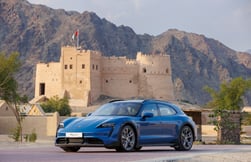We cherish firsts and bests in the region, and when the opportunity arose to test drive the newly launched Rimac Nevera, we eagerly embraced it.
The Nevera boasts several accolades, including being the fastest-accelerating production car globally and the fastest electric production car in the world, both independently verified. This masterpiece, whose namesake is a Mediterranean storm that comes out of nowhere and blows away everything in its path, is the brainchild of Croatian national Mate Rimac. With its impressive achievements, the Nevera will secure a prominent place in automotive history.
A five-year journey commenced with a blank sheet of paper. Through an arduous development stage, 18 different prototypes were crafted and subjected to 45 physical crash tests. The Rimac team reveals that the entire process demanded approximately 1.6 million collective hours to breathe life into the Nevera.
Mate Rimac, now serving as the CEO of Automobili Rimac and the Bugatti Rimac Group, has a story that traces back 15 years. It all began in his garage, where he embarked on a mission to convert his BMW E30 M3 to an EV – a venture that would make his fellow countryman, Nikola Tesla, immensely proud. Today, Mate and his team have grown to include over 2,200 employees.
The details
The Rimac Nevera lives up to its name as the world’s fastest electric car. It features a proprietary 120kWh liquid-cooled H-shaped battery, developed in-house. The battery design positions the driver and passenger as low to the ground as possible. The second-generation Rimac All-Wheel Torque Vectoring system, along with four motors, delivers an impressive 1,914 horsepower and 2,340 Nm of torque. Accelerating from 0-100 km/h takes a mere 1.81 seconds, while 0-300 km/h takes 9.22 seconds. Moreover, its top speed is 412 km/h, all despite weighing 2.3 tons. With a remarkable range of 490 km, courtesy of its substantial battery capacity, it is evident that there is currently no production car that rivals its performance. For those considering range and battery concerns, the Nevera addresses them with an impressive 490 km range.

The car
Hypercars often come with uncomfortable features for the driver, a scenario that Mate Rimac and the team aimed to avoid, particularly considering the exclusive ownership limited to only 150 fortunate individuals who will experience the pleasure of owning the €2 million + (approximately AED7.9 million) Nevera.
Inside the cabin, it’s challenging to find non-bespoke parts for the Nevera. The seats are both sporty and comfortable, complemented by an in-house developed infotainment system that is slick, user-friendly and efficient. The cabin is intelligently designed to minimize distractions. During my test drive with Rimac’s chief test pilot, Miroslav Zrncevic, I curiously inquired about the location of the cruise control, only to be met with silence and a meaningful glance. “This is a driver’s car….”
While Rimac engineered the Nevera for ultimate performance, it doesn’t compromise on the luxurious amenities evident in its hefty price tag. The interior boasts plush leather, an excellent sound system and ample space. The cockpit design incorporates all essential elements. It features a well-defined separation between analog and digital buttons to ensure the driver’s focus remains on driving rather than navigating buttons and screens. Rimac emphasizes their goal of making “digital” technology feel analog, engaging, and rewarding for the driver.

Read: Experiencing the Lamborghini Huracán Sterrato’s dual personality in Porto Cesareo
Performance and drive
What distinguishes the Nevera and Rimac as a brand is their unique approach of developing key vehicle systems in-house, tailored to their specifications. Rimac crafts components such as traction control and regenerative braking (even during ABS activation). Moreover, it designs active aerodynamics, monocoque and safety structures and high-voltage and low-voltage harness (HV & LV harness). In addition, it crafts Electronic Control Units (ECUs), and on-board chargers (OBC) in its facilities on the outskirts of Zagreb, Croatia.
The Nevera offers five driving modes and an additional two programmable by the driver: Range, Cruise, Sport, Track and Drift. Moreover, it offers Custom 1 & 2, ensuring a suitable option for every driving surface. Monitored by an on-board supercomputer, the car assesses 4,500 signals from numerous vehicle systems multiple times per second. This capability enables the vehicle to navigate challenging roads with precision. Moreover, it allows it to swiftly accelerate to speeds exceeding 300 km/h on the track, executing controlled drifts through narrow corners.
In essence, the Rimac Nevera stands out as a unique and technologically advanced hypercar, brought to life through the vision of an entrepreneur with a commitment to innovation.
For more on cars and boats, click here.








